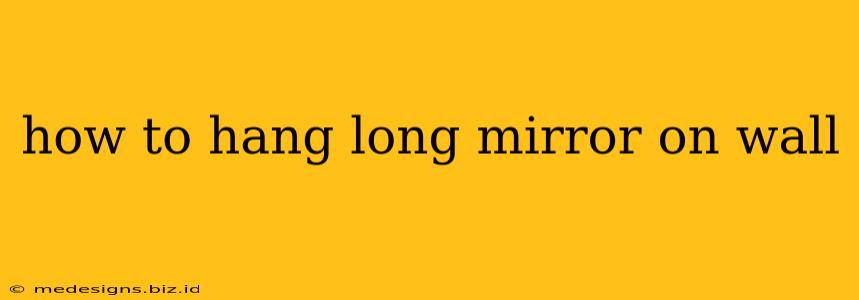Hanging a long mirror can dramatically transform a room, adding depth, light, and style. But getting it up safely and securely requires careful planning and execution. This guide will walk you through the process step-by-step, ensuring your beautiful new mirror is displayed perfectly and safely.
Assessing Your Mirror and Wall
Before you even think about grabbing a hammer, you need to assess two crucial elements: your mirror and your wall.
1. Understanding Your Mirror:
- Weight: This is the most crucial factor. A heavy mirror requires more robust hanging hardware. Weigh your mirror accurately – you can use a bathroom scale if necessary.
- Material: Is it framed or frameless? The material of the frame (wood, metal, plastic) will influence your hanging method. Frameless mirrors require extra care.
- Hanging Hardware: Does it come with pre-installed hanging hardware? If not, you'll need to purchase appropriate hardware.
- Size and Shape: A long, narrow mirror will have different hanging needs than a large, rectangular one.
2. Evaluating Your Wall:
- Wall Type: Is it drywall, plaster, brick, concrete, or something else? Different wall types require different types of wall anchors. Drywall is the most common and requires special attention.
- Stud Location: Locate the wall studs using a stud finder. Hanging your mirror directly on studs is the strongest and most secure method.
- Wall Strength: Consider the overall strength of the wall. If the wall is weak or damaged, you may need to use stronger anchors or find an alternative hanging location.
Choosing the Right Hanging Hardware
Selecting the right hardware is essential for a secure and damage-free installation. Here’s a breakdown of common options:
1. For Lightweight Mirrors:
- Picture Hanging Hooks: Suitable for mirrors weighing less than 10 pounds. These are easy to install and are a great option for drywall.
- Adhesive Strips: For very lightweight mirrors (under 5 pounds). These are convenient but may not be suitable for all wall types or high-humidity environments. Always check the weight limits of the adhesive strip.
2. For Heavier Mirrors:
- Heavy-Duty D-Rings and Wire: These are commonly used for larger and heavier mirrors. The D-rings are screwed into the back of the mirror, and a wire is attached to hang it.
- French Cleats: A clever and extremely strong hanging system. A cleat is attached to the back of the mirror and a matching cleat is screwed to the wall. This allows for easy hanging and leveling.
- Heavy-Duty Wall Anchors: For drywall, these are essential for heavier mirrors. Choose anchors specifically designed for the weight of your mirror.
Hanging Your Long Mirror: A Step-by-Step Guide
- Plan Your Placement: Use painter's tape to mark the desired position of the mirror on the wall. This allows you to visualize the placement before committing.
- Locate Studs (if possible): Use a stud finder to locate wall studs. Hanging the mirror directly onto studs is the most secure method.
- Install Hardware: Carefully install the chosen hanging hardware onto the back of the mirror and the wall, following the manufacturer's instructions. For drywall, use appropriate anchors to prevent the mirror from pulling out.
- Hang the Mirror: Carefully hang the mirror onto the wall hardware, ensuring it is level. Use a level to check for perfect alignment.
- Secure the Mirror: Once the mirror is in place, ensure it is securely fastened and will not easily shift or fall.
- Inspect: Step back and visually inspect your work, ensuring the mirror is correctly hung, level, and secure.
Safety Precautions
- Wear safety glasses: Protect your eyes from any potential debris or falling objects.
- Work with a partner: This is especially important for heavier mirrors. Having a second person helps to ensure safe and stable hanging.
- Use the correct tools and hardware: Do not compromise on quality to avoid accidents.
- Check weight limits: Always check the weight limits of the hanging hardware before hanging the mirror.
Hanging a long mirror can be a rewarding DIY project. By following these steps and prioritizing safety, you can successfully and securely display your beautiful new mirror, transforming your space in the process. Remember, if you're uncomfortable with any aspect of this process, it's always best to consult a professional.
